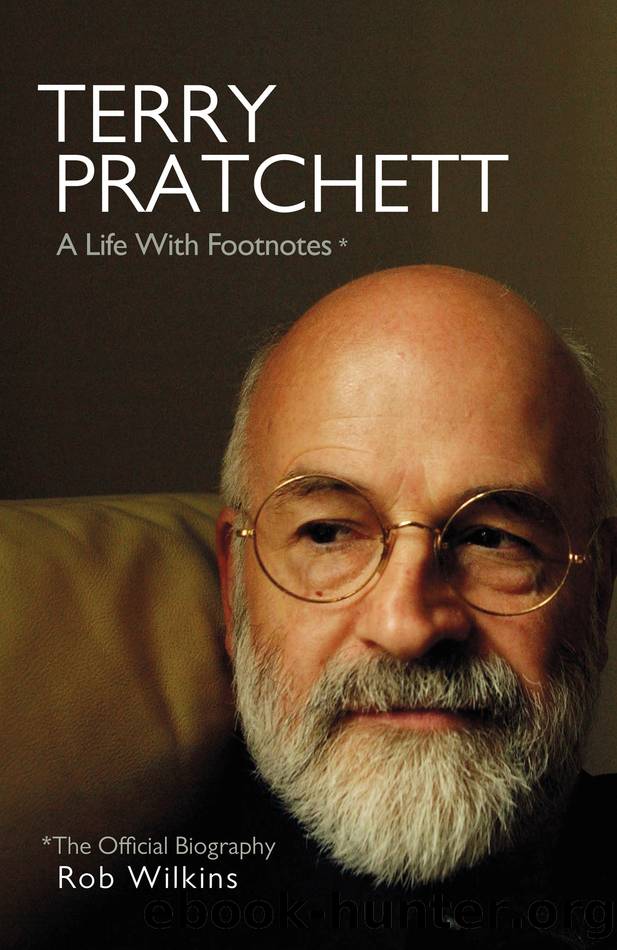Terry Pratchett: A Life With Footnotes by Rob Wilkins

Author:Rob Wilkins [Wilkins, Rob]
Language: eng
Format: epub
Publisher: Penguin Random House UK
Published: 2022-07-25T00:00:00+00:00
13
Curried Sultanas, Marmalade and Corrugated Iron
In the summer of 1995, a Terry Pratchett fan was in a craft shop called Curiosity Corner in Lavenham in Suffolk, browsing its selection of officially licensed Discworld figurines. After careful deliberation, he chose the Dried Frog Pill Boxfn1 and took it to the counter.
âYou read Terry Pratchett?â the man at the till asked.
The fan replied that he did â that he had read the lot, in fact, and been to a couple of book signings, too.
âWell, you might be interested in this,â the shopkeeper said.
He handed the fan a leaflet from a pile on the counter, advertising something called the âClarecraft Discworld Eventâ.
Which is how, on 12 August 1995, I ended up in a tin-roofed warehouse on a business estate in a mined-out sandpit on the edge of the Suffolk village of Woolpit. Because, reader, I was that Terry Pratchett fan. To be frank, in my naivety, I thought I would be the only person there. I was out by several hundred.
The hosts of this slightly thrown-together, rough-at-the-edges but well-attended and above all extremely cheerful Discworld gathering â the first of its kind â were Bob and Trish Baker. They owned both the tin-roofed warehouse and Clarecraft Ltd, the company upon which Terry had bestowed the licence for the creation of Discworld-related collectables. Such as, for example, the Dried Frog Pill Box (catalogue number, DW63), but also, as my shelves at the time would have attested, the model of Rincewind (DW01), Death on Binky (DW24)fn2, and the limited edition âskinnyâ variant of the Nanny Ogg figure (DW07), of which, I can confidently inform you, there were only a dozen made.fn3
Clarecraftâs founders were Bernard and Isobel Pearson. Since 1980, they had been creating, in their Suffolk studio, individually made models and sculptures, mostly in ceramic or pewter, and including some pieces commissioned by the Tolkien Foundation. Isobel had heard The Colour of Magic on Womanâs Hour and began reading the books; Bernard was initially put off by the Josh Kirby covers, which werenât to his taste, but he overcame his reservations when he saw how much Isobel enjoyed the novels, and he tore through them, too. In 1990, they decided to look into the possibility of exploiting an obvious gap in the market by reimagining some of Terry Pratchettâs fictional world as highly desirable, hand-crafted and hand-painted figurines. All this was entirely in accordance, of course, with the immutable law linking fantasy writing and collectable ornaments since time immemorial: where there is fantasy, collectable ornaments will not be far behind. That much is simply understood.
Terry longed to see his literary creation brought to life in this way â but only, it probably doesnât need saying, on his own, very precise terms. Selling the licence for Discworld merchandise to some kind of giant, plastic toy empire appealed to Terry not one bit; selling it, on the other hand, to a garrulous, pipe-smoking policeman-turned-potter who was part of a bohemian husband-and-wife sculpting team that had named their
Download
This site does not store any files on its server. We only index and link to content provided by other sites. Please contact the content providers to delete copyright contents if any and email us, we'll remove relevant links or contents immediately.
Periodization Training for Sports by Tudor Bompa(8170)
Why We Sleep: Unlocking the Power of Sleep and Dreams by Matthew Walker(6618)
Paper Towns by Green John(5089)
The Immortal Life of Henrietta Lacks by Rebecca Skloot(4525)
The Sports Rules Book by Human Kinetics(4290)
Dynamic Alignment Through Imagery by Eric Franklin(4116)
ACSM's Complete Guide to Fitness & Health by ACSM(3989)
Kaplan MCAT Organic Chemistry Review: Created for MCAT 2015 (Kaplan Test Prep) by Kaplan(3939)
Introduction to Kinesiology by Shirl J. Hoffman(3725)
Livewired by David Eagleman(3683)
The Death of the Heart by Elizabeth Bowen(3551)
The River of Consciousness by Oliver Sacks(3538)
Alchemy and Alchemists by C. J. S. Thompson(3449)
Bad Pharma by Ben Goldacre(3355)
Descartes' Error by Antonio Damasio(3230)
The Emperor of All Maladies: A Biography of Cancer by Siddhartha Mukherjee(3064)
The Gene: An Intimate History by Siddhartha Mukherjee(3047)
The Fate of Rome: Climate, Disease, and the End of an Empire (The Princeton History of the Ancient World) by Kyle Harper(3003)
Kaplan MCAT Behavioral Sciences Review: Created for MCAT 2015 (Kaplan Test Prep) by Kaplan(2936)
